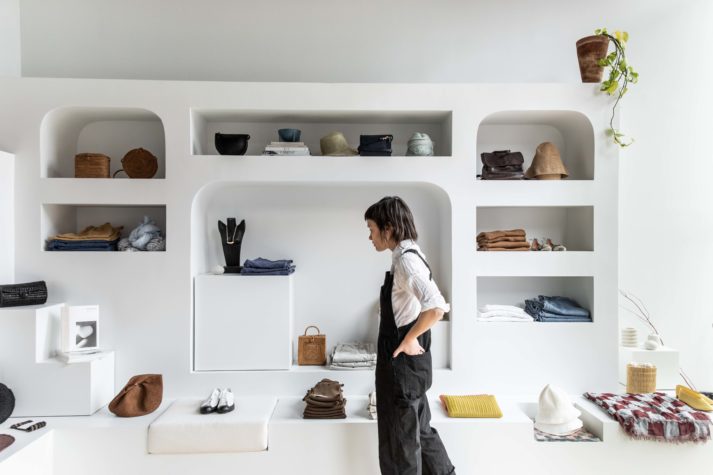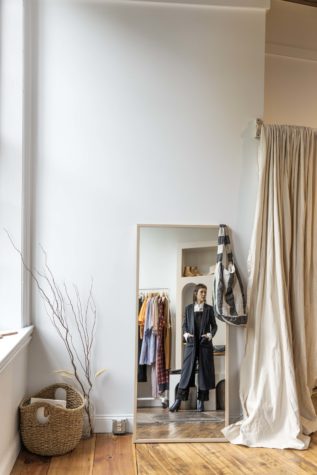Seeking Style
With an eye toward ethical fashion, Brooke Beaney has created a space full of thoughtful “slow” garments at her Old Port boutique.
Getting dressed has always been a struggle for some of us. No matter the season, I find myself spending far too much time standing in front of an open closet, thinking about how I want to present myself, who I want to be that day. It’s not that I don’t like my clothes—I do! I like them a lot. But I’ve never found a uniform that works for me, and, for a long time, I thought this made me a stylistic failure. I assumed that people either understood fashion or they didn’t. Not so, according to Brooke Beaney, owner of Judith, one of Portland’s most interesting and conceptual boutiques. According to Beaney, indecision and curiosity are good things. “If you’re interested in clothing and fashion, you never really solve your style,” she says. “You won’t stop being interested in clothes, pushing your style forward, refining it, and editing it.”
Hearing this from Beaney, who walks around town in fabulous, put-together outfits and hosts designer trunk shows in her Old Port space, felt like a revelation. She seems like an expert on clothing, yet in conversation she makes it clear that she doesn’t have all the answers. She understands her own personal style and outlook, and she understands the fashion business, and she uses this knowledge to help people find the objects that speak to them. “We talk a lot at Judith about having no false sales,” she says. “It doesn’t matter if we think something looks amazing on you, you need to feel like it looks amazing on you. All of the work here is valid and can find its right home—it just needs to find its person.”
Judith feels a bit like a gallery. The store opened officially in April 2014 on Market Street and has since moved to a much larger space on Middle Street (a good sign for any small business). “We have 3,000 square feet of retail floor space now,” Beaney says. “It’s been a total learning curve figuring out how it works.” (Hence why they haven’t affixed any of the clothing racks permanently to the floor or ceiling.) Although Beaney sells art items and objects as well, the emphasis is always on the clothing. She’s passionate about design, independent labels, aesthetics, and ethics. It sounds like a mixed bag of values, but it hangs together neatly, thanks to Beaney’s rigorous vetting process. “I can only sell things when I really know what the brand is about, know the people who are involved, know the designer myself,” she explains.
Beaney sharpened her stylistic chops in New York City working as a knitwear designer for brands like Inhabit and Nanette Lepore. “I always knew I wanted to have a store,” she says. And she knew it wouldn’t be in New York. “I found shopping in New York so arduous. It felt like work.” Whenever she came to Maine on vacation (something she did every year with her husband), she would visit local shops. “I wished, when I was here, that there was a place that was an amalgamation of all my favorite stores in New York, a place where I could shop when I was in my vacation headspace,” Beaney says. “I wouldn’t have opened my store here if it already existed; Judith would have landed somewhere else.”
Now Judith is several years old, and the store still carries many of the brands that Beaney originally loved, such as Caron Callahan, Jesse Kamm, Rachel Comey, Ulla Johnson, and Ace and Jig, plus some new ones including Ichi Antiquites, Town Clothes, Batsheva, and Reality Studio. Although she’s hesitant to describe the style that prevails at Judith (“I don’t think I want to put it into words,” she says, “I want the work to speak for itself”), there is a clear through line. The designers tend to be independent and offer ethically made clothing (or “slow and thoughtful things,” as Beaney puts it). When it comes to cut and shape, the clothes are fashionable and experimental, but not so bold as to be shocking. They are made of high-quality fabrics and tend to drape on the body in interesting ways. Beaney has an eye for choosing patterns that feel familiar yet never cliché. Judith, Beaney admits, won’t be for everyone. But everyone is welcome to come in and see if anything resonates. “What I really don’t want is for the store to feel precious,” she says. She has the same hopes for her high-end clothes. “Your clothes can all be things that you love, that you throw on with ease. We want the clothing to make you feel amazing.”
Wear it Well
The key to building a wardrobe that feels inspirational and beloved, Beaney says, comes from picking pieces that feel “effortless.” That means something different for everyone. “If you are going to spend a lot of money on a piece, it shouldn’t be something you never wear,” says Beaney. “You deserve to wear clothing you love and feel great in every day.” She suggests imagining how many times you will wear a particular piece in a year, and choosing versatile items that can be dressed up or down.
Consider your palette.
Are you the type of person who gravitates toward neutrals, or do you love primary colors? Find the tones that suit you and then build a wardrobe that varies in textures and fabrics. Mix silk with wool and leather, and play with proportions to add interest to a fairly monochromatic look.
Embrace the reality of your clothes.
They will show signs of wear, and they will show signs of your movement.“I think clothes look best when they are lived in,” says Beaney. “I’m all for scrunching up sleeves, wrapping and tucking in a cardigan, and using a longsleeve shirt or cardigan to create an off-kilter apron effect when wearing a sack dress or oversized jumpsuit.” Play with how you wear your clothes to get more mileage out of each item.
Take care of your clothes.
Sometimes, Beaney says, people tend to think that “expensive, considerate” items are bulletproof. But items don’t last a lifetime unless you give them proper care. Learn what fibers are in your sweater if you want to know whether it will pill, and consider the detailing on your dress before you wear it during moving day.










